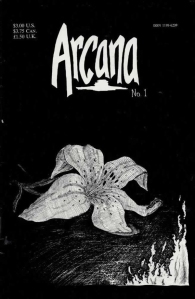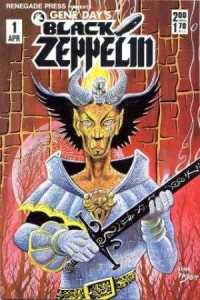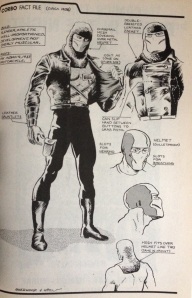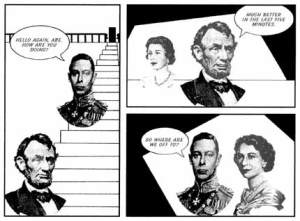 Arnold Alexander Saba was born in Vancouver in February of 1947. He was born into a wealthy family and the eldest of four children. He began drawing comics at a young age, having had a very fertile environment in which to develop his skills. His mother, Allison McBain, was a cartoonist and comics enthusiast herself, and granddaughter of Mary “Dolly” Collins, a Manitoba cartoonist. Predominantly raised on newspaper strips and collections of Caniff and Barks, most of Saba’s earliest renderings are in a similar vein.
Arnold Alexander Saba was born in Vancouver in February of 1947. He was born into a wealthy family and the eldest of four children. He began drawing comics at a young age, having had a very fertile environment in which to develop his skills. His mother, Allison McBain, was a cartoonist and comics enthusiast herself, and granddaughter of Mary “Dolly” Collins, a Manitoba cartoonist. Predominantly raised on newspaper strips and collections of Caniff and Barks, most of Saba’s earliest renderings are in a similar vein.
In 1965, Saba attended the University of British Columbia for Journalism and Print Production. During Arn’s time in school, he involved himself in theatre in both performance and writing. He also practiced cartooning for the school paper which, he explains, “eventually devolved into a story that featured songs.” This is not unlike a comic he created in highschool about dancing and singing garbagemen.
However, it wasn’t until 1975 that he first published Neil the Horse, the comic that dominated his cartooning career. Stylistically, the comic is most reminiscent of early Disney cartoons, but because of the mélange of characters, styles and forms, it transgresses any real comics tradition. Saba experimented with many forms of pop culture not normally associated with comics such as paper cut outs, musicals and dances.
In 1977, Saba moved from Vancouver to Toronto to be immersed in the Canadian comics scene and he continued to develop Neil the Horse, publishing it in a multitude of forums.
Oddly, I didn’t really think about or plan anything musical when I started Neil. I mean, there never had been any such comic, and my eye was firmly on “the great traditions” when I got going. And I wanted to find my place amongst those greats. But I could tell right away that I had to find my own footing. Every great cartoonist and great strip, those who really projected a unique voice, had done so by gradually finding that voice. And it had to be the creator’s own genuine voice, whatever that may be. Herriman could not have envisioned in advance Krazy Kat’s sweet mystery. Barks never planned to make Donald an everyman. Foster likely never imagined that his chivalric adventure strip would grow to include domestic soap opera. Caniff, essentially a hayseed, probably never sat around imagining he would write sophisticated male-and-female repartee. And so on. They all followed their noses, and developed what they did best, a day at a time.
The comic found its footing, because in 1980 Saba published one of these stories with Potlach Publications in the 1980 Comics Annual.
Then again in 1982 with Dave Sim and Deni Loubert in the “Unique Story” section of Cerebus No. 41, 44 and 45. In February 1983, Neil the Horse graduated and was featured in his own book published by Sim and Loubert’s company Aardvark-Vanaheim.
 Saba was even deeper in the comics community as he was also developing a five-part radio documentary on CBC, The Continuous Art, which explored the cultural position of comics. He conducted many interviews including those with Milton Caniff, Floyd Gottfredson, Hugo Pratt, Will Eisner, Jules Feiffer, and Russ Manning. His interview with Hal Foster is famous for being Foster’s last interview. Also on the radio at this time was Saba’s radio musical called Neil and the Big Banana which did very well.
Saba was even deeper in the comics community as he was also developing a five-part radio documentary on CBC, The Continuous Art, which explored the cultural position of comics. He conducted many interviews including those with Milton Caniff, Floyd Gottfredson, Hugo Pratt, Will Eisner, Jules Feiffer, and Russ Manning. His interview with Hal Foster is famous for being Foster’s last interview. Also on the radio at this time was Saba’s radio musical called Neil and the Big Banana which did very well.
Although Neil survived the separation of Aardvark Vanaheim titles, it only lasted 15 issues, the last of which came out in 1988. This did not mean the end of Neil. Between the years of 1988 to 1993, Neil the horse was optioned in Hollywood and Saba began taking Neil in all possible directions.
Saba was pursuing three avenues of publication: the stage musical, the graphic novel and the TV series. In September of 1993, all three were rejected. It was at this point Saba decided to abandon hopes of developing Neil the Horse and began to pursue other options. During this time he had been living in San Francisco for five years, and had begun to realize his transsexual transition. By the end of 1994, this transition was completed, and Saba began a new life as Katherine Collins. During the rest of her new life, she no longer pursued comics, either as a journalist or creator until recently. In August 2013, Collins was inducted into the Shuster Award Hall of Fame and Hermes picked up the rights to reprint the collection in its entirety.
Currently, Hermes Press is suffering from financial problems and they’re trying to raise the funds in Indiegogo. The restoration complete, these funds will go toward actually printing the book.
















